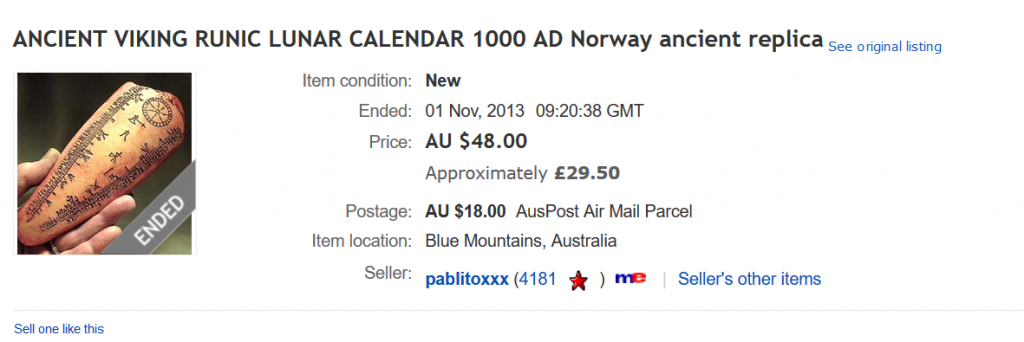You can find memes like the one below claiming that it depicts a “Viking rune stone calendar”

When I first looked into the rune calendars some years ago I also found the same picture on eBay. Notice that it is called a “replica”.

So, we now know that the picture depict a replica. Actually, the original probably doesn’t exist anymore (unless it is found forgotten in some museum or private collection). But we do know that there was an original. The Danish Antiquarian Ole Worm depicted it in his book “Fasti Danici, universam tempora computandi rationem antiquitus in Dania et vicinis regionibus observatam libris tribus exhibentes.” from 1643
It cen be seen on the picture below.

Arild Hauge says on his page, that the Danish museums have been searched to find the calendar depicted, but it haven’t been found. It also says on Arilds page, that Ole Worm wrote that the calendar was carved into a bone from a large fish, but it may be that it is a whalebone (and not a stone as the meme claims).
Then there are the claim that the calendar is from the Viking Age. The oldest description we have of the runic calendars are in the book: “Historia de Gentibus Septentrionalibus (A Description of the Northern Peoples)” from 1555 by Olaus Magnus. The oldest rune calendar that we know about is one on parchment from the island of Gotland. Its calendar is from 1328, but was destroyed in the great fire of Copenhagen in 1728. Fortunately, the notes Ole Worm made of the calendar still exist.
The runic calendars are perpetual calendars, who has its inspiration from the European church calendars. They follow a moon circle, so that the one that uses the calendar can find both the fixed and the moving Christian holydays (like Easter, which follow the moon circles). It is assumed that the runic calendar’s goes back to the 13th century.
So it is very clear that the calendar in the picture isn’t an “ancient rune stone Calendar 100 a.d. Norway”. The only true statement is that it is a rune Calendar and is from Norway (and it only show summer months by the way, since Ole Worm didn’t reproduce the other side).
Sources:
Enoksen, Lars Magnar: Runor
Sweden 1998
Hauge: Arild: RUNEKALENDER
https://www.arild-hauge.com/runekalender.htm